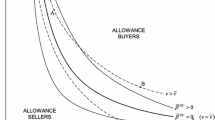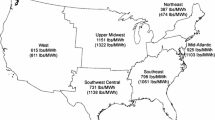Abstract
This paper examines the economic logic of integrated assessment — balancing the costs against the benefits of greenhouse gas abatement. “Stylized facts” are employed in a multiregion computable general equilibrium model with a public good. The percentage shares of global emissions are determined outside the model — based upon some form of international agreement — and emission rights are tradeable between regions. The analysis is confined to Pareto-optimal (cooperative) solutions. We focus on the sensitivity of initial decisions to low-probability, high-consequence scenarios associated with cumulative emissions. For simplicity, there are only two regions, two tradeable goods, two time periods, and two states-of-world. With the particular form of public good model adopted here (production rather than utility function impacts), it turns out that a Pareto-optimal hedging strategy is indepedent of the emission shares allocated to each region. Equity issues may be separated from those of economic efficiency. Similar results extend to cases in which there are additional regions, tradeable goods, time periods, and states-of-world.
Similar content being viewed by others
References
A. Brooke, D. Kendrick and A. Meeraus,GAMS: A User's Guide, Scientific Press, Redwood City, CA, 1988.
J. Hammitt, R. Lempert and M. Schlesinger, A sequential-decision strategy for abating climate change, Nature 357 (1992).
C. Hope, J. Anderson and P. Wenman, Policy analysis of the greenhouse effect, Energy Policy 21 (1993).
A. Manne, R. Mendelson and R. Richels, MERGE—a model for evaluating regional and global effects of GHG reduction policies, Working Paper, Electric Power Research Institute, Palo Alto, CA, 1993.
A. Manne, Greenhouse gas abatement — toward Pareto-optimality in integrated assessments, Working Paper, Department of Operations Research, Stanford University, 1994.
W. Nordhaus, To slow or not to slow: The economics of the greenhouse effect, Economic Journal 101 (1991).
W. Nordhaus,Managing the Global Commons — The Economics of Climate Change, MIT Press, Cambridge, MA, 1994.
T. Olsen, Greenhouse gas abatement — joint maximization under uncertainty, Doctoral Dissertation, Department of Operations Research, Stanford University, 1994.
S. Peck and T. Teisberg, CETA: A model for carbon emissions trajectory assessment, Energy Journal 13 (1992).
T. Rutherford, Sequential joint maximization, Working Paper, University of Colorado, 1992.
Author information
Authors and Affiliations
Rights and permissions
About this article
Cite this article
Manne, A.S., Olsen, T.R. Greenhouse gas abatement — toward Pareto-optimal decisions under uncertainty. Ann Oper Res 68, 267–279 (1996). https://doi.org/10.1007/BF02209615
Issue Date:
DOI: https://doi.org/10.1007/BF02209615




